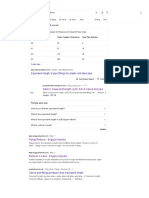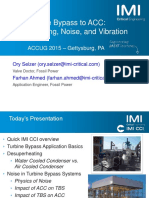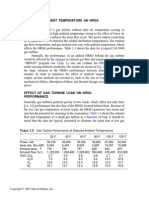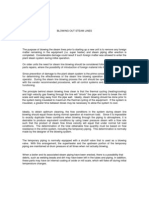Turbine Bypass System - HORA
Turbine Bypass System - HORA
Uploaded by
hozipekCopyright:
Available Formats
Turbine Bypass System - HORA
Turbine Bypass System - HORA
Uploaded by
hozipekCopyright
Available Formats
Share this document
Did you find this document useful?
Is this content inappropriate?
Copyright:
Available Formats
Turbine Bypass System - HORA
Turbine Bypass System - HORA
Uploaded by
hozipekCopyright:
Available Formats
HORA Turbine Bypass System
Turbine Bypass.doc
Seite 1 von 11
31. Oktober 2003
HORA Turbine Bypass System
Application A turbine bypass system permits operation of the boiler independently from the steam turbine during start-up, commissioning, turbine trip (shut down) and load alternations. It gives a higher plant availability and operational flexibility over all different operating conditions. The start-up time under cold, warm and hot conditions is reduced. Keeping the thermal transient in the boiler to a minimum continuous flow through superheater and reheater (maintained tube cooling) must be provided and the pressure during the entire start-up has to be controlled. A turbine bypass system is in operation until desired steam conditions from metal temperatures of rotor and casing of the turbine are matched. This method reduces the solid particle erosion to the turbine also, since the loss of material from the boiler internals most likely occurs during start-up. After a load rejection of the turbine the bypass valves operate the boiler at an optimal standby load and avoid a boiler trip. They equal the difference between the steam generator and the turbine flow. It is a big advantage that commissioning of the boiler can be carried out totally independent of the turbine. Boiler trials that are usual when commissioning the firing system are performed without stressing the turbine unnecessarily.
The HP-bypass valve is sized for 100% steam capacity of the boiler to reduce the pressure integrated with desuperheating (PRDS) to cold reheat conditions. It has to protect the live steam piping system. If there is no reheater the steam has to be conditioned down to acceptable condenser levels. The valve can operate as an safety valve with the necessary fast opening devices. With those fast acting actuators the lifting of the spring loaded safety valves with the associated seat maintenance can be avoided and energy and water keep in the water-steam-circle.
Turbine Bypass.doc
Seite 2 von 11
31. Oktober 2003
HORA Turbine Bypass System
The IP(HRH)/ LP-bypass valves are typically used to divert the steam away from the turbine to the condenser. They have to protect the reheat piping system. A fast closing device for condenser protection during transient operating periods is also integrated. Due to the radical increase in the specific volume of the steam it is often necessary to use a dump tube downstream as a final pressure reduction to get a higher backpressure after the bypass valve. The size of the valve can be minimized. In combined heat and power plants bypass valves are required to deliver steam with exact temperature and pressure to the process (e.g. paper mills). Because of the different steam demands the range draws from a various number of HP to LP bypass systems. In case of a back pressure turbine trip the process steam has to be produced over the PRDS.
Control concept For normal bypass operation, no extraordinary demands are made on opening and closing times. The temperature after a HP bypass valve is used as control signal for the spray water control valve. To operate the PRDS as a safety valve at a turbine trip HORA recommends a feed forward signal before the control goes back to the temperature sensors. This is due to the loss of control of the spray water valve because it cannot follow the fast opening of the PRDS closely enough to keep the downstream temperature within normal operating limits. Too much unevaporated water or too little water leads to errors in the temperature readings. Therefore at first a heat balance calculation of the steam conditions and the valve position of the bypass valve determine the required water amount and related valve position followed by the control via the temperature sensors. For LP bypass valves the heat balance concept is used in general because the steam setpoint temperature is near or at saturation condition and therefore a temperature sensor cannot be used as control signal.
Turbine Bypass.doc
Seite 3 von 11
31. Oktober 2003
HORA Turbine Bypass System
Design Water injection with nozzle
The HORA steam conditioning valve with a fixed size spray nozzle is specifically designed for low capacity applications where the load is fairly constant (process steam PRDS). The water is injected with a special axial full cone stainless steel spray nozzle directly in the seat area of the pressure reducing valve. This section has the highest steam velocity. The conditioning is realised by an ideal mixing of the turbulent steam with the atomized water. The result is a rapid evaporation with a good control.
The water can have a share in comparison to the steam up to 20%. Above this ratio, a decent evaporation of the spray water is not guaranteed.
Turbine Bypass.doc
Seite 4 von 11
31. Oktober 2003
HORA Turbine Bypass System
Water injection with orificed tube
A advanced steam conditioning system is developed by HORA by means of a proportional water injection directly after the first stage of pressure reducing (e.g HP Turbine Bypass Valve). This way you have always the right mix, an optimal spray and a quick evaporation of the water is realised.
The cooling water is supplied through an orificed tube which is fixed within the valve body. The holes to let in the cooling water are covered by a perforated plug. A variable number of holes is opened through the axial movement of the plug. The appropriate number, size and arrangement of the holes determines the injection of the water so as to ensure the right proportion to the amount of steam reduced at any time. Therefore the atomization and evaporation is optimal over the complete range. In case of supercritical pressure drops a further reduction of pressure and noise is implemented by a number of subsequently arranged perforated cages and discs
Turbine Bypass.doc
Seite 5 von 11
31. Oktober 2003
HORA Turbine Bypass System
Turbine Bypass.doc
Seite 6 von 11
31. Oktober 2003
HORA Turbine Bypass System
Water injection with integrated atomizer unit
When critical requirements have to be fulfilled an integrated atomizer unit for the cooling water injection offers the best possible results by using the kinetic energy of the critical steam flow (e.g. IP/LP Turbine Bypass Valves). A separate arrangement of the cooler is also possible. An atomizer is particularly used at the following requirements:
-
Steam cooling close to saturation temperature High water/ steam ratio (->high temperature drop) Large steam flows Available cooling water pressure is less than half the steam pressure
In a PRDS the high pressure steam is tapped after the first reducing stage - the perforated plug. If the perforated plug is closed the flow of the supporting steam to the atomizer is stopped too. Therefore an additional on-off valve is not required. The steam is introduced through steam ports to the spray water holes arranged in a circle and leaves the two component nozzle with supersonic speed. These jets of steam blast the cooling water to atomize it in order to cause fine droplets distributed into the steam header.
Steam
Water
The water enters the centre of the spray head and then the number of radial holes, sized to suit quantity and pressure drop in accordance to the requested flow. There at the narrowest crossection (highest speed) the water is dragged along and atomized by the tapped high pressure steam. The evaporation of the finest droplets is rapid. The flow of the water is controlled by a separate spray water valve. An atomizer is very effective under partial load conditions because the atomizing steam is constantly flowing when the valve is in use. With it an inner protection pipe is not required.
Turbine Bypass.doc
Seite 7 von 11
31. Oktober 2003
HORA Turbine Bypass System
Turbine Bypass.doc
Seite 8 von 11
31. Oktober 2003
HORA Turbine Bypass System
General installation instructions We recommend a minimum straight pipeline before the valve of 5 x DN and downstream 10 x DN. In this pipe section there should not be any components present; T-shaped junctions must be avoided. The injection water must be clean water (e.g. boiler feedwater) with a constant pressure as indicated on the HORA data sheet and a temperature near to saturation (>100C). We recommend a strainer with a fine sieve (aperture width: 0,5mm) ahead of the water control valve. The spray water control valve should always be installed below the level of the injection point to ensure that the line remains full under low load conditions. In order to be able to carry out any mounting work on the control valve during operation, tight shut-off valves in a appropriate distance before and after the valve and a bypass are required. It must be possible to drain the shut-off pipe section. In non critical conditions a distance to the temperature sensor of min. 5m is required. In range applications an arrangement of 3 sensors with a high value selection is recommended For immediate operational use the valve should be heated (kept warm). Depending on use and application (e.g. stand-by operation) warm up lines are required to prevent the collection of condensate and critical thermal stress (thermoshock) within the valve. A drain line at the lowest point of the system is required. Accumulation of condensate has to be avoided absolutely because of danger from water hammer and erosion.
Seite 9 von 11 31. Oktober 2003
Turbine Bypass.doc
HORA Turbine Bypass System
Turbine Bypass.doc
Seite 10 von 11
31. Oktober 2003
HORA Turbine Bypass System
Turbine Bypass.doc
Seite 11 von 11
31. Oktober 2003
You might also like
- H02-011 - Calculation of Gas Density and ViscosityDocument26 pagesH02-011 - Calculation of Gas Density and Viscosityamir_hayfaNo ratings yet
- Heat ExchangerDocument4 pagesHeat ExchangerIzwanaRahimiNo ratings yet
- 78 Loss of Excitation SIEMENS PaperDocument10 pages78 Loss of Excitation SIEMENS PapermohamedseragNo ratings yet
- 3 Element Drum Level ControlDocument3 pages3 Element Drum Level ControlSriteja Josyula100% (1)
- Write Up On Aux PrdsDocument6 pagesWrite Up On Aux PrdsYousuf AliNo ratings yet
- CEMS-2000BF DatasheetDocument5 pagesCEMS-2000BF DatasheetPajnuNo ratings yet
- Gas Turbine ProtectionDocument29 pagesGas Turbine ProtectionMohammed Hamza Ahmed100% (2)
- Process GCs/Process Analyzers (Total VOCs)Document4 pagesProcess GCs/Process Analyzers (Total VOCs)Jennifer MaclachlanNo ratings yet
- TND 063191 135912Document180 pagesTND 063191 135912Kanupriya AgarwalNo ratings yet
- Failure of Gearbox Cooling Tower Fan in Cement Mill 1607659041Document15 pagesFailure of Gearbox Cooling Tower Fan in Cement Mill 1607659041Muhtiar Darja100% (1)
- Equivalent Length of A Reducer - Google SearchDocument3 pagesEquivalent Length of A Reducer - Google SearchzoksiNo ratings yet
- HD ND ZUE - enDocument28 pagesHD ND ZUE - enwylie01No ratings yet
- Product Specification: Forbes-Bryan Low Corrosion Tray Type Deaerator - 5Mw To 400MwDocument3 pagesProduct Specification: Forbes-Bryan Low Corrosion Tray Type Deaerator - 5Mw To 400MwCarlos ACNo ratings yet
- Bypass 06.O.Selzer - IMI-CCI-Impact-of-ACC-on-TBS-Desup-Noise-VibrationDocument56 pagesBypass 06.O.Selzer - IMI-CCI-Impact-of-ACC-on-TBS-Desup-Noise-VibrationChirag SabalparaNo ratings yet
- EMERSON Standard COATING SPECIFICATIONDocument9 pagesEMERSON Standard COATING SPECIFICATIONYadir SánchezNo ratings yet
- GT Load Effect On HRSGDocument3 pagesGT Load Effect On HRSGsatishchemeng100% (1)
- CRH Drain Pot LevelDocument30 pagesCRH Drain Pot LevelBibhash SinghNo ratings yet
- 36 มยผ.8116-52 มาตรฐานแผงควบคุมเครื่องสูบน้ำดับเพลิงDocument21 pages36 มยผ.8116-52 มาตรฐานแผงควบคุมเครื่องสูบน้ำดับเพลิงappril26No ratings yet
- Cuproplex Cleaning of GeneratorDocument20 pagesCuproplex Cleaning of GeneratorJayanath Nuwan SameeraNo ratings yet
- Automation 4Document84 pagesAutomation 4heru hsNo ratings yet
- M624 MBATech Electrical Subrat Sharma Final ReportDocument64 pagesM624 MBATech Electrical Subrat Sharma Final ReportJosef MorganNo ratings yet
- Deluge Valve - SD-DVA PDFDocument15 pagesDeluge Valve - SD-DVA PDFboxyfunNo ratings yet
- 3 Element ControllerDocument3 pages3 Element ControllermgkvprNo ratings yet
- Gorter r200Document6 pagesGorter r200Manish SaraswatNo ratings yet
- Pressure Regulating ValvesDocument1 pagePressure Regulating ValvesarasNo ratings yet
- Test Code For Cooling Tower SlidesDocument12 pagesTest Code For Cooling Tower SlidesFouzan AbdullahNo ratings yet
- Deluge Valve Model-H2: HD Fire Protect Pvt. Ltd. (Cast Steel) Technical DataDocument16 pagesDeluge Valve Model-H2: HD Fire Protect Pvt. Ltd. (Cast Steel) Technical DataNethajiNo ratings yet
- My Latest CV - EngineerDocument3 pagesMy Latest CV - EngineersasibhushanNo ratings yet
- A4 Desuperheater PDFDocument6 pagesA4 Desuperheater PDF련서긔No ratings yet
- Datasheet t5500 t6500 Pressure GaugesDocument5 pagesDatasheet t5500 t6500 Pressure GaugesEdy WijayaNo ratings yet
- 1a.calibration of OrificemeterDocument7 pages1a.calibration of OrificemeterArjun P PNo ratings yet
- Cooling Water System Control Philosophy (25Mw) : ObjectiveDocument8 pagesCooling Water System Control Philosophy (25Mw) : ObjectiveEric Taylor100% (1)
- Drum Level CompensationDocument8 pagesDrum Level CompensationSmriti PrasadNo ratings yet
- Design and Control of A Vapour Recompression C3 SplitterDocument14 pagesDesign and Control of A Vapour Recompression C3 SplitterZangNo ratings yet
- Micro ScannerDocument2 pagesMicro ScannerArun KumarNo ratings yet
- Boiler Drum Level Measurement and ControlDocument13 pagesBoiler Drum Level Measurement and Controlasdmoom100% (2)
- Sur - Flo Turbine MeterDocument40 pagesSur - Flo Turbine MeterCheng HuangNo ratings yet
- Gross Turbine Cycle Heat Rate Ch-8.2Document12 pagesGross Turbine Cycle Heat Rate Ch-8.2levelhead28No ratings yet
- Monitor Feedwater Heater PerformanceDocument1 pageMonitor Feedwater Heater PerformanceknsaravanaNo ratings yet
- Turbine Bypass SystemsDocument10 pagesTurbine Bypass SystemsZaqPoilm100% (1)
- 67CF Series Filter RegulatorsDocument8 pages67CF Series Filter RegulatorsAlberto CastellanosNo ratings yet
- Sentry Sampling ComponentsDocument60 pagesSentry Sampling Componentsnagaraj108100% (3)
- Float Board Level GaugeDocument6 pagesFloat Board Level GaugeanaismariaNo ratings yet
- Sizing of Steam Lines PDFDocument4 pagesSizing of Steam Lines PDFsakalidhasavasanNo ratings yet
- Construction Check Sheet Control Valve Pre-Installation Calibration I-003ADocument1 pageConstruction Check Sheet Control Valve Pre-Installation Calibration I-003AKailash PandeyNo ratings yet
- Valve Sizing and Selection: FREE ResourcesDocument6 pagesValve Sizing and Selection: FREE ResourcesSARATH KRISHNAKUMARNo ratings yet
- 3 Ways To Align A Centrifugal Pump PDFDocument4 pages3 Ways To Align A Centrifugal Pump PDFabidch143No ratings yet
- By Pass RotameterDocument6 pagesBy Pass Rotameterkrishna kumarNo ratings yet
- Hydraulic & Pneumatic Systems in Automotive VehiclesDocument2 pagesHydraulic & Pneumatic Systems in Automotive VehiclesWork WearautoNo ratings yet
- Primary Air SystemDocument13 pagesPrimary Air SystemTan Nguyen HuuNo ratings yet
- Chapter 4 HRSGDocument39 pagesChapter 4 HRSGGloria Del Carmen Muñoz100% (2)
- EvaporatingDocument5 pagesEvaporatingFadhil KhalidNo ratings yet
- Report HRSGDocument3 pagesReport HRSGOBENG JohnNo ratings yet
- Deaerator MDT SeriesDocument9 pagesDeaerator MDT Seriesz3kh4No ratings yet
- Basic Desuperheater TypesDocument28 pagesBasic Desuperheater Typesshan07011984100% (2)
- ETO BoilerDocument28 pagesETO BoilerTsega YeNo ratings yet
- Steam Jet Refrigeration SystemDocument3 pagesSteam Jet Refrigeration Systemnikhilgogoi80No ratings yet
- 5 HRSG 11 12Document7 pages5 HRSG 11 12M Moarraf Naeem100% (2)
- Steam Jet Spindle Operated ThermocompressorDocument3 pagesSteam Jet Spindle Operated ThermocompressorjfejfeNo ratings yet
- Metering DevicesDocument8 pagesMetering DevicesKudzai ManyanyeNo ratings yet
- Steam BlowingDocument6 pagesSteam BlowingS V NAGESH100% (1)
- Torque Speed CurveDocument4 pagesTorque Speed CurvehozipekNo ratings yet
- Installation Guidelines For C&I Installation of Flow InstrumentsDocument19 pagesInstallation Guidelines For C&I Installation of Flow InstrumentsCharu ChhabraNo ratings yet
- A Review On Boiler Deposition-Foulage Prevention and Removal Techniques For Power PlantDocument6 pagesA Review On Boiler Deposition-Foulage Prevention and Removal Techniques For Power PlanthozipekNo ratings yet
- Combustion Basics: The Chemistry of CombustionDocument6 pagesCombustion Basics: The Chemistry of CombustionhozipekNo ratings yet
- Boilers, Superheaters and Reheaters - Babcock & Wilcox CompanyDocument0 pagesBoilers, Superheaters and Reheaters - Babcock & Wilcox Companyhozipek0% (1)
- Double-Frequency Stator Core Vibration in Large Two-Pole TurbogeneratorsDocument292 pagesDouble-Frequency Stator Core Vibration in Large Two-Pole TurbogeneratorshozipekNo ratings yet
- Generator In-Situ Inspections - GER3954CDocument16 pagesGenerator In-Situ Inspections - GER3954Chozipek100% (1)
- Cooling Tower Performance and Sensors For Thermal-Fluid SystemsDocument11 pagesCooling Tower Performance and Sensors For Thermal-Fluid Systemshozipek5599No ratings yet
- Electrical Operation of Electrostatic PrecipitatorsDocument285 pagesElectrical Operation of Electrostatic PrecipitatorsDentist Dentist Dentist100% (5)
- Turbine Supervisory Instrumentation Selection Guide - RockwellDocument52 pagesTurbine Supervisory Instrumentation Selection Guide - Rockwellhozipek100% (2)
- Design of A Chimney With GRP Liner For Low and High Temperature OperationDocument5 pagesDesign of A Chimney With GRP Liner For Low and High Temperature OperationhozipekNo ratings yet
- Graphs of Trigonometric FunctionsDocument21 pagesGraphs of Trigonometric FunctionshozipekNo ratings yet








































































